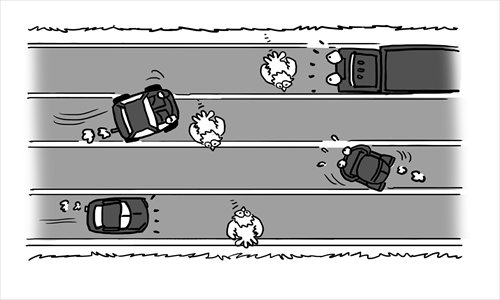Fighting jaywalking is a battle of the mind

Ever since the 2004 TV series Chinese Style Divorce, a story about the chaotic and disappointing marital life of a middle-aged couple, became a sensation in China, the phrase "Chinese style" has been a mainstay of the modern Chinese vocabulary.
There is "Chinese style marriage," meaning mainly you have to purchase an apartment before the wedding. There is "Chinese style competition," meaning to open a shop next door to your competitor and sell exactly the same products.
But one such phrase, "Chinese style road crossing," despite its popularity at this moment, may not qualify as an entry.
The typical way a pedestrian crosses the road in China, as summarized by netizens, is "waiting, not until the light changes, but until a crowd forms."
No one cares whether they have the right of way. The only thing that matters is to stride ahead in a group that is big enough to attract the attention of the coming cars so they won't be hit.
This summer, the authorities in many major cities, such as Beijing and Shenzhen, all started to zero in on unruly pedestrians by handing out fines from 10 to 50 yuan ($1.63 to $8.15).
But this isn't just a Chinese affliction. Many cities in the US have been annoyed by the same peeve for a long time.
Indeed, US cities like Denver and San Diego have launched similar operations.
But while people in China may have high expectations for their newly unveiled programs, most people in the US don't believe the crackdowns will have any long-term effect.
Harvard Crimson, the campus daily newspaper of Harvard University, published an article in 1962 warning that Cambridge, the city where the university is located, would start to enforce the then newly passed anti-jaywalking law. Today, a visit to Harvard Square will show just how ancient the warning sounds.
Bigger cities like New York have basically given up their enforcement against jaywalkers. The 1998 attempt by former mayor Rudy Giuliani to post a $50 penalty on violators only ended with laughter from not only the pedestrians but also his own police officers. Mind you, this is the iron-fisted mayor who managed to halve the city's crime rate during his time in charge.
And the current Mayor Michael Bloomberg, when asked about cracking down on jaywalking in a radio show last year, said: "It's not a bad idea. I just think in a real sense we're not going to get it done."
This inertia has a lot to do with the limited resources of law enforcement. But an even more daunting challenge is that the public has accepted jaywalking as part of everyday life.
In the 13 years I have lived in New York, I have witnessed numerous city officials jaywalking. My husband almost insists on doing it, seeing it as some weird badge of honor.
It didn't take me long to realize that you won't be perceived by others as a proud New Yorker until you become a bold jaywalker.
China may be facing similar challenges. The pilot programs now in place all found themselves hampered by the shortage of traffic officers.
In China, there may be many more defiant pedestrians than in the US, and they are quite likely to curse the police, bargain over the amount of the penalty, or simply run away when they are found to be violating the rule. But they have a similar mind-set with New Yorkers when it comes to the moral weight of jaywalking.
This is best presented in a video clip that has gone viral online, in which a traffic policeman tries to educate a violator about the rule during the grace period for Shenzhen's anti-jaywalking operation. The young woman sarcastically plays with the officer, and then says: "If I got hit by a car because of jaywalking, then I deserve it. It's my life. But why should it be your business?"
If the Chinese authorities can overcome those attitudes through the campaigns, they can claim a world-class victory even without eradicating jaywalking.
And by then, the endeavor will deserve to be called a "Chinese style" crackdown, which will certainly be the envy of other parts of the world.
The author is a New York-based journalist. rong_xiaoqing@ hotmail.com